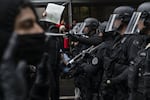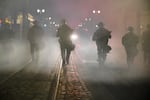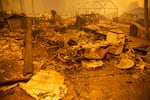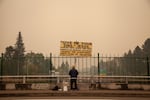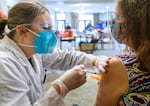This was the year of literal and metaphorical fires, of existential angst and true life and death terror.
This was a year of big, often heart-wrenching events: COVID-19, the police killing of George Floyd and the fight for racial justice, wildfires and climate change, political upheaval, economic crisis.
In any other year, each of these huge stories would be the only thing we’d talk about in the annual rundown of major news. Each has changed Oregon and Washington in ways that are not yet clear.
But here’s the painful reality for everyone toasting the end of 2020 and hoping turning the calendar over also turns over our collective luck: In the Pacific Northwest, we end this rotten, world-altering year with more questions than answers and with important, hard work left to do.
COVID-19

OHSU nurse practitioner Shelby Freed tests a patient for COVID-19 at a drive-up testing station in Portland, Ore., in this file photo.
Bradley W. Parks / OPB
All things considered, Oregon and Washington got lucky, at least compared to many other parts of the country. Although Washington state saw the United States’ first confirmed coronavirus outbreak, leaders in both states acted firmly and quickly. The result: The comparative death toll in the Northwest hasn’t risen as high as some other places.
Still, COVID-19 fundamentally changed how we live. Remote learning became the — not always successful — norm. Businesses closed. Restaurants and bars tried to adapt. Oregon’s vibrant arts community ground to a stop, found solace in creation and struggled to figure out what’s next.
The vaccines are here, but the rollout has already proven shaky as Oregon, Washington and many other states received fewer doses than anticipated. Public health officials worry about the anti-vaccine sentiment they discovered in certain parts of the Pacific Northwest during the 2019 measles outbreak.
And they’ve barely begun to solve another preexisting condition COVID-19 made obvious: As with so many other health crises in Oregon and Washington, coronavirus hit communities of color harder.
Racial justice

A group of protesters arrives at the Mark O. Hatfield federal courthouse in Portland, Ore., July 25, 2020. Portland has sustained protests against police brutality and systemic racism for 58 days.
Bradley W. Parks / OPB
The protests in Portland began quickly after Minneapolis police killed George Floyd. They stretched through the summer and into the fall, leading to budget changes at the Portland Police Bureau, smaller but similar protests in other parts of the state and, for a few violent weeks, a federal occupation.
The movement led to changes. The city of Portland got rid of several controversial units within the police bureau, including armed officers in public schools. State legislators met in an unusual special session in part aimed at racial justice.
But activists say the steps of 2020 are just the start of what’s needed to truly make Oregon equitable and dismantle a legacy of white culture: widespread changes in both the political and economic makeup of the state. It’s unclear whether the political will exists to make that happen — and whether the momentum and uniquely singular focus of the summer protests will last into 2021.
Wildfires
And then the state caught fire.
Climate change, rampant development and plain human carelessness have made wildfires the summer norm in the West. In September, a dangerous mix of heavy winds, low humidity and drought conditions led to fires that swept across much of the state. At one point, more than 500,000 Oregonians were under some kind of evacuation order, including suburbanites on the outskirts of Portland.
The fires killed 11 people, burned more than 1 million acres and turned the air toxic. Entire communities were wiped out.
As with COVID-19, communities of color were among the worst affected. And in a foreboding sign of what could come in future wildfire seasons — or a major earthquake — some of the emergency response systems designed to warn people of impending danger failed.
The next fire season is just a few months away.

Wildfire smoke turns the sky orange at the Oregon Capitol in Salem, Ore., Sept. 8, 2020. Unprecedented wildfire conditions across Oregon and the American West kicked up several fires over Labor Day weekend.
Bradley W. Parks / OPB
Political upheaval — sort of
2020 was the year when everything changed, except the political status quo.
At the state level, Gov. Kate Brown fended off yet another recall attempt and won mostly plaudits — outside of the occasional lawsuit — for her handling of COVID-19. Senate President Peter Courtney entered the year seemingly wounded by repeated Republican walkouts and the rise of a younger, more diverse collection of Senate Democrats. He leaves it exactly where he’s been since 2003 — atop the state Senate. House Speaker Tina Kotek faces a challenge from Rep. Janelle Bynum, but it’s unclear whether Bynum has the votes — and she certainly doesn’t have them without Republican help.
The biggest sign of generational change came in the race for Oregon’s second-highest elected office. In the May primary, longtime state Sen. Mark Hass lost to his younger and more liberal colleague, Shemia Fagan. Fagan easily won the November general election, taking back the only statewide office Republicans had held and positioning her as the leader of a younger, more progressive wing of the state Democratic Party.
Washington state similarly saw mostly more of the same. Gov. Jay Inslee, fresh off a failed presidential campaign, easily won reelection and, so far at least, did not win a place in a President-elect Biden’s administration.
In Oregon’s largest city, Portland Mayor Ted Wheeler had a dreadful year. His odd, oddly constructive relationship with Commissioner Jo Ann Hardesty fell apart amid the summer’s protests, and he faced criticism from both the left and the right over his handling of the federal intervention, as well as his own police agency’s use of force against protesters and journalists.
And yet on election day, Wheeler became the first Portland mayor in a generation to win a second term. Commissioner Chloe Eudaly was beaten by a less progressive challenger, Mingus Mapps, and the City Council as a whole emerged from a year of protest and calls for dramatic change more inclined to side with business interests and more moderate Portlanders.
Oregon Republicans suffered another rough year in 2020. They did manage to prevent Democrats from picking up enough state legislative seats to prevent more GOP walkouts. But along with losing the secretary of state’s race and failing to recall Brown, they also ended the year, yet again, without a clear leader or a clear philosophical focus for life after President Donald Trump. The next governor’s race is less than two years away, and there is no GOP frontrunner.
So what comes next?
The protests have become less frequent, the rainy season has arrived, and an end to lockdown life is in sight.
But the damage of this year, and the massive holes in our economic and social safety nets these collective crises revealed, will take a long time to even understand, let alone solve.
Students will return to campus soon, but they’ll be going back to schools that were stretched to the financial breaking point even before COVID-19.
Businesses are reopening, but the fundamental problems facing Oregon’s economy — a revenue structure inherently imbalanced toward income taxes, an economy dominated by the types of small businesses and creative industries especially vulnerable to financial slowdown — have only been exacerbated by all these months in economic stasis.
Protests may be less frequent, but they’re no less emotional — or less violent — and the economic, health and environmental gaps between white Oregonians and Oregonians of color grow wider by the day.
It’s distinctly possible 2021 will be calmer, kinder and less calamitous than 2020, that a combination of vaccines, a new administration and general exhaustion lead Oregon and Washington back to something like normal.
It’s also possible 2020 was normal.
